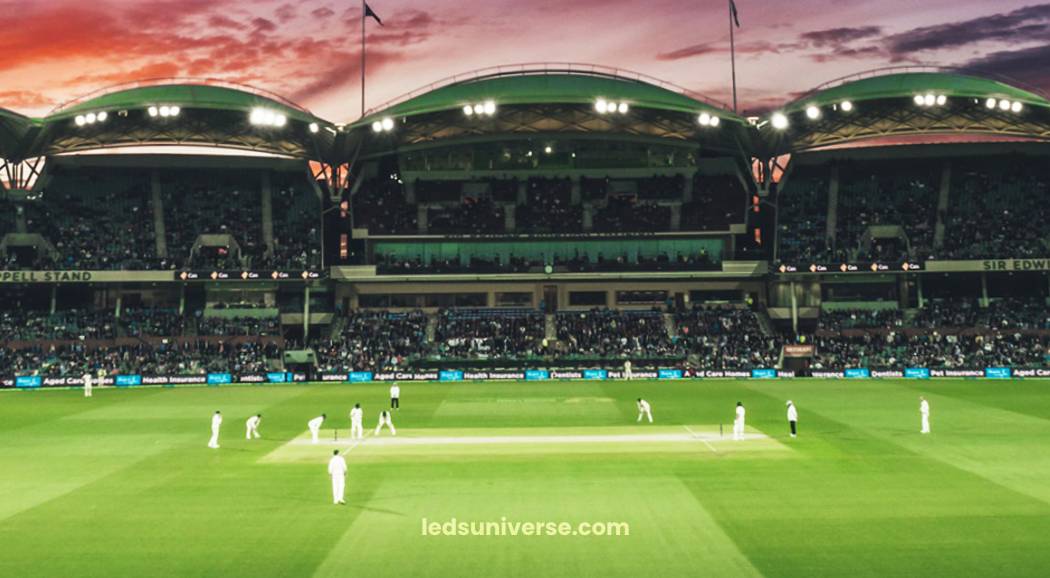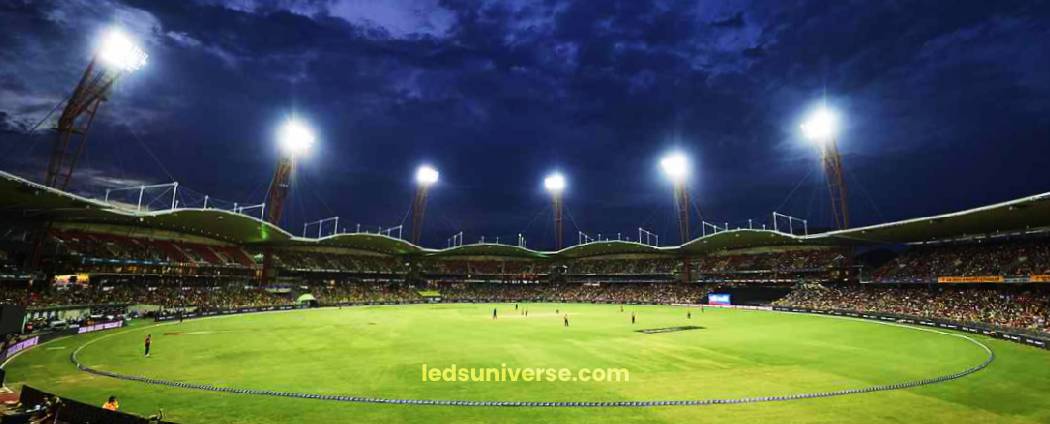Imagine a thrilling cricket match unfolding under the floodlights, the sound of the bat hitting the ball echoing through the stadium, and fans cheering from the stands. For modern-day cricket, lighting is not just an afterthought; it’s an integral part of the game.
The illumination of cricket fields not only enhances the playing experience but also ensures that matches can take place during evening hours, attracting more spectators and offering better visibility for players. However, installing and maintaining a cricket field lighting system comes with significant costs. These expenses are affected by various factors, including the size of the field, the type of lighting system, and the geographic location.
Reach out for free lighting consultation
Table of Contents
ToggleThe expenses associated with cricket field lighting can be broken down into several areas: installation, operational costs, and maintenance. Each of these components contributes to the overall expense, and understanding them will help in formulating a realistic budget. In this section, we will explore each of these areas in more detail.
| Component | Description | Estimated Cost |
|---|---|---|
| Lighting Equipment Costs | LED floodlights typically used for high-intensity illumination. Costs depend on wattage, size of the field, and brand. | $400 to $1,500 per unit |
| Poles and Mounting Structures | Poles needed to support the floodlights, typically ranging in height from 15 to 25 meters. Costs vary based on material and height. | $500 to $2,000 per pole |
| Installation Costs for Poles | Labor and installation for poles, considering factors like soil conditions and foundation requirements. | $1,000 to $3,000 per pole |
| Electrical Infrastructure | Infrastructure to power the system, including transformers, circuit breakers, wiring, and connections to the power grid. | $10,000 to $30,000 |
| Labor Costs for Installation | Costs for specialized technicians and engineers required for safe and efficient installation. | $15,000 to $50,000 |
| Energy Consumption and Costs | Energy usage of floodlights, which vary depending on wattage and hours of operation. Average stadium with 30 floodlights consuming 30 kWh per hour for five hours of use. | $15 to $40 per match |
| Power Usage and Peak Hours | Costs can fluctuate depending on electricity pricing during peak or off-peak hours. | Varies based on location and time of use |
| Lamp and Bulb Replacement | Replacement of LED floodlight bulbs (30,000 to 50,000 hours lifespan). Cost of bulbs varies depending on wattage and brand. | $100 to $300 per bulb |
| Annual Lamp Replacement for 20 Floodlights | Estimated cost to replace several bulbs annually for a 20-light system. | $1,000 to $5,000 |
| General Maintenance and Repairs | Regular maintenance for cleaning, wiring checks, and electrical repairs. | $1,000 to $5,000 per year |
| Safety and Compliance | Additional safety measures such as barriers, grounding systems, or surge protection to meet local regulations. | Varies based on location and safety requirements |

When setting up a cricket field lighting system, the first financial commitment involves the cost of installation. Installation costs cover everything from selecting the lighting equipment to wiring and electrical infrastructure, as well as the labor required to set up the system. The installation expenses can vary depending on the size and complexity of the system, but these costs can be categorized as follows:
The type of lighting equipment chosen is one of the factors influencing the overall cost. Floodlights, specifically LED floodlights, are typically used in cricket fields due to their ability to provide high-intensity illumination over a large area. On average, LED floodlights cost between $400 and $1,500 per unit, depending on their wattage and brand. The wattage of floodlights can range from 200 watts for smaller systems to 2,000 watts for larger, more powerful installations.
The number of floodlights needed depends on the size of the cricket field and the level of lighting required. A standard cricket field may require between 12 to 30 floodlights. For example, smaller local grounds may use fewer floodlights, while larger stadiums or professional venues require more lights to achieve sufficient illumination.
To support the floodlights, poles and mounting structures are required. These poles need to be strong enough to withstand weather conditions and hold the lights at the correct height for optimal illumination. The height of the poles typically ranges from 15 to 25 meters. The poles themselves can cost between $500 to $2,000 each, depending on the material used, the height of the pole, and whether they are custom-designed or pre-fabricated.
Additionally, installation costs for the poles can range from $1,000 to $3,000 per pole. These costs will vary based on the complexity of the installation, including factors such as soil conditions, pole foundation requirements, and local labor rates.
The electrical infrastructure required to power the lighting system includes transformers, circuit breakers, wiring, and switches. The cost of this infrastructure is determined by the number of floodlights being used, the wattage of each light, and the distance from the power source to the lighting system. On average, electrical infrastructure for a cricket field can cost between $10,000 and $30,000. This cost will also include the cost of connecting the lighting system to the local power grid.
Labor costs are another component of the installation process. The installation of a cricket field lighting system requires specialized technicians, electricians, and engineers to ensure that the system is installed safely and efficiently. Labor costs can vary depending on the location and the complexity of the project. On average, labor costs for a complete installation may range from $15,000 to $50,000, depending on the scale of the project.
Once the lighting system is installed, there are ongoing operational costs associated with running the system. The most substantial ongoing cost is electricity, as the lighting system will consume a significant amount of power during each match or training session. These operational costs include the following:
Energy consumption is the factor in determining operational costs. The amount of electricity consumed depends on the wattage of the lights, the number of floodlights, and how long they are used during each match. LED floodlights typically consume between 200W and 2,000W each. For example, a stadium with 30 LED floodlights, each consuming 1,000 watts, will consume approximately 30 kWh of energy per hour.
Assuming that the lights are used for five hours during an evening match, the total energy consumption would be 150 kWh per match. The cost of electricity varies from location to location, but in many regions, the cost per kilowatt-hour (kWh) can range from $0.10 to $0.25. Based on these rates, the operational cost per match would range from $15 to $40, depending on the energy rate in the area.
Cricket fields with lighting systems may see varying costs depending on the time of day when matches or practice sessions are scheduled. If the matches take place during peak electricity hours, the cost of electricity could be higher. In contrast, fields operating during off-peak hours may benefit from lower energy rates. This variance is particularly important for fields located in areas where electricity pricing fluctuates based on demand.
Maintaining the cricket field lighting system is an ongoing expense that helps ensure the system continues to operate efficiently. Maintenance costs include replacing damaged lights, cleaning the floodlights, and addressing any electrical issues that may arise. These maintenance expenses can vary depending on the type of lighting system used, the age of the equipment, and the local environmental conditions.
While LED lights have a longer lifespan than other types of lighting (such as metal halide or high-pressure sodium lamps), they still require occasional replacements. Typically, LED floodlights can last anywhere from 30,000 to 50,000 hours before needing replacement. However, the cost of replacing LED lamps can range from $100 to $300 per bulb, depending on the wattage and brand.
For a cricket field with a system of 20 floodlights, replacing a few bulbs annually can cost between $1,000 and $5,000. The cost of labor to replace the bulbs will also be an additional expense.
In addition to replacing lamps, regular maintenance will be required to keep the lighting system functioning optimally. This may involve cleaning the floodlights, checking electrical components for wear and tear, and ensuring the wiring is secure. General maintenance costs can vary depending on the size of the system, but on average, the maintenance costs for a cricket field lighting system range between $1,000 and $5,000 per year. Larger stadiums may experience higher maintenance costs.
Certain cricket field lighting systems may require additional safety measures to ensure compliance with local regulations. This could involve the installation of safety barriers, grounding systems, or surge protection systems. These safety measures help prevent accidents and ensure the lighting system is safe to operate. The cost of implementing these safety measures will vary based on local laws and the complexity of the system.

By making smart choices when it comes to equipment selection, installation, and maintenance, it’s possible to minimize expenses without sacrificing the quality of the lighting system.
The most effective way to reduce operational costs is by investing in energy-efficient lighting solutions. LED floodlights are an excellent option because they use significantly less power than traditional lighting systems. Although LED lights may have a higher upfront cost, they offer long-term savings due to their lower energy consumption and extended lifespan. In fact, LED floodlights can reduce electricity costs by up to 50% when compared to metal halide or high-pressure sodium lights.
In addition, advanced lighting control systems can be employed to reduce energy usage. Dimming the lights when full brightness is not required or using automated timers to ensure lights are only on when needed can further cut down on electricity consumption.
One way to further reduce operational costs is by installing solar-powered lighting systems. These systems use solar panels to convert sunlight into electricity, which is stored in batteries for use at night. While the initial installation of solar-powered lighting systems can be costly, the long-term savings are substantial, especially in regions with abundant sunlight. Some reports suggest that solar-powered lighting can reduce energy costs by as much as 80%.
Additionally, solar-powered lighting systems have lower maintenance costs and a smaller environmental footprint, making them a popular option for environmentally-conscious cricket field owners.
A proactive approach to maintenance can save money over the long term. By ensuring that the lighting system is regularly inspected and repaired as needed, field owners can avoid costly emergency repairs. Routine maintenance such as cleaning the lights, replacing faulty wiring, and addressing minor issues before they escalate can prolong the lifespan of the system and reduce the frequency of expensive replacements.
The size and configuration of the lighting system are factors in determining the overall cost. Oversized lighting systems can result in unnecessary energy consumption, whereas undersized systems may fail to provide sufficient illumination for both players and spectators. Optimizing the size of the lighting system according to the needs of the cricket field is a cost-effective strategy. Field owners should take into consideration the size of the ground, expected crowd, and the level of play when determining the number and type of floodlights to install.
Smaller venues may not require as many floodlights as larger professional stadiums, and installing the correct number of lights can help balance operational costs with lighting quality.
By investing in energy-efficient lighting systems, considering solar-powered options, and maintaining the equipment regularly, cricket field owners can reduce both installation and ongoing operational costs. With careful planning and smart decision-making, it’s possible to balance quality lighting with budget constraints, ensuring that cricket matches can be enjoyed well into the night without breaking the bank.